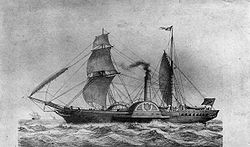Sirius (ship, 1837)
|
||||||||||||||
|
||||||||||||||
|
||||||||||||||
|
||||||||||||||
The Sirius from 1837 was the first steamship to cross the Atlantic exclusively with the then new propulsion system.
Launch
The Sirius was built at the Robert Menzies & Son shipyard in Leith for the Saint George Steam Packet Co. , a well-known shipping company from Liverpool at the time , which was dedicated to the movement of goods between the British Isles. So the Sirius was actually intended for the liner service between London and Cork .
The Sirius was a wooden two-master rigged like a schooner brig, that is, it carried square sails on the foremast and a large fore-sail on the mainmast. The side balancing machines, which developed 320 hp , were attached amidships between the two masts . Technically uncharted territory were the surface condensers stationed on deck , with the use of which it was possible for the first time to use fresh water for steam generation on sea steam ships .
On loan to New York
At the same time as the Sirius was being completed in Leith, the era of steamers across the Atlantic began . The ocean crossing quickly resembled a race. The British and American Steam Navigation Company , which was founded in Liverpool in 1838 and one of its competitors, ran into serious scheduling problems: the completion of its own overseas steamer British Queen was delayed. The company then chartered the Sirius in April 1838 for a single Atlantic crossing to New York .
On April 4, 1838, under the command of Lieutenant Richard Roberts , the Sirius left the port of Cork with 40 passengers on board for New York. Despite persistent rough winds, she reached Manhattan on April 23, 1838 after 18 days and 4 hours as the first continuously steam-powered ship with an average speed of 8.03 knots .
During the crossing a few days before entering the New York harbor, the crew is said to have been forced to burn the furniture and an emergency mast because the coal in the ship's bunkers was quickly used up. According to information, the crew has divided the coal consumption at sea per day so that the Sirius still had 15 tons of coal on arrival. However, this thesis has never been refuted.
On the same day, just under four hours later, the legendary Great Western of Isambard Kingdom Brunel arrived on its maiden voyage in New York. This steamship did not leave until three days later, so it was much faster than its rival, the Sirius .
In June 1838, the steamship crossed the Atlantic again.
The rest of your career
After crossing the Atlantic, the Sirius returned to the Saint George Steam Packet Co. and henceforth served the line from Cork to Glasgow for nine years. In 1847 she was stranded on the cliffs of Ballycotton Bay in the south of Ireland while traveling from Cork to Glasgow with a stopover in Dublin, causing 20 deaths.
literature
- Kozak, Jaromir: Pocket Atlas of Ships . 6th German edition Hanau 1986; ISBN 3-7684-2389-1
- Frank Binder: Spectacular race 175 years ago . In: Daily port report of April 23, 2013, p. 15
- Michaels-reisetagebuch.com
